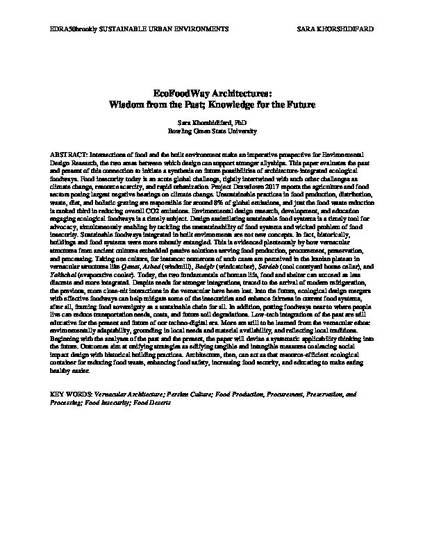
Article
EcoFoodWay Architectures: Wisdom from the Past; Knowledge for the Future
The Environmental Design Research Association Conference Proceedings
(2019)
Abstract
Intersections of food and the built environment make an imperative prospective for Environmental Design Research, the two areas between which design can support stronger allyships. This paper evaluates the past and present of this connection to initiate a synthesis on future possibilities of architecture-integrated ecological foodways. Food insecurity today is an acute global challenge, tightly intertwined with such other challenges as climate change, resource scarcity, and rapid urbanization. Project Drawdown 2017 reports the agriculture and food sectors posing largest negative bearings on climate change. Unsustainable practices in food production, distribution, waste, diet, and holistic grazing are responsible for around 8% of global emissions, and just the food waste reduction is ranked third in reducing overall CO2 emissions. Environmental design research, development, and education engaging ecological foodways is a timely subject. Design assimilating sustainable food systems is a timely tool for advocacy, simultaneously enabling by tackling the unsustainability of food systems and wicked problem of food insecurity. Sustainable foodways integrated in built environments are not new concepts. In fact, historically, buildings and food systems were more robustly entangled. This is evidenced plenteously by how vernacular structures from ancient cultures embedded passive solutions serving food production, procurement, preservation, and processing. Taking one culture, for instance: numerous of such cases are perceived in the Iranian plateau in vernacular structures like Qanat, Asbad (windmill), Badgir (windcatcher), Sardab (cool courtyard house cellar), and Yakhchal (evaporative cooler). Today, the two fundamentals of human life, food and shelter can succeed as less discrete and more integrated. Despite needs for stronger integrations, traced to the arrival of modern refrigeration, the previous, more close-nit interactions in the vernacular have been lost. Into the future, ecological design mergers with effective foodways can help mitigate some of the insecurities and enhance fairness in current food systems, after all, framing food sovereignty as a sustainable chain for all. In addition, putting foodways near to where people live can reduce transportation needs, costs, and future soil degradations. Low-tech integrations of the past are still educative for the present and future of our techno-digital era. More are still to be learned from the vernacular ethos: environmentally adaptability, grounding in local needs and material availability, and reflecting local traditions. Beginning with the analyses of the past and the present, the paper will devise a systematic applicability thinking into the future. Outcomes aim at unifying strategies as edifying tangible and intangible measures coalescing social impact design with historical building practices. Architecture, then, can act as that resource-efficient ecological container for reducing food waste, enhancing food safety, increasing food security, and educating to make eating healthy easier.
Keywords
- Vernacular Architecture; Persian Culture; Food Production,
- Procurement,
- Preservation,
- and Processing; Food Insecurity; Food Deserts
Disciplines
Publication Date
Fall November 12, 2019
DOI
https://cuny.manifoldapp.org/read/ecofoodway-architectures-wisdom-from-the-past-knowledge-for-the-future/section/5273ad97-2629-4ff0-a39b-ce2a386d5892
Citation Information
Sara Khorshidifard. "EcoFoodWay Architectures: Wisdom from the Past; Knowledge for the Future" The Environmental Design Research Association Conference Proceedings (2019) Available at: http://works.bepress.com/sara_khorshidifard/21/
Creative Commons license

This work is licensed under a Creative Commons CC_BY-NC-ND International License.
